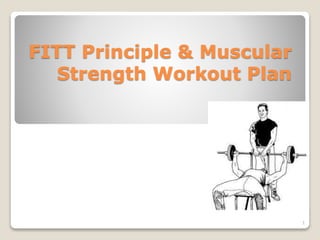
Fitt principle
- 1. FITT Principle & Muscular Strength Workout Plan 1
- 2. FITT: Your Exercise Prescription 2 Frequency: how often you work. Intensity: how hard you work. Time: the length of time, or duration, that you work. Type: the specific type or mode of activity you choose.
- 3. FITT Principle The first FITT factor is frequency. Factors to consider with Frequency: - Cardiovascular Conditioning - Your current fitness level 3 Term to Know Frequency Refers to the number of times per week you engage in physical activity or exercise.
- 4. FITT Principle The second FITT factor is intensity. Ways to determine Intensity: -Target Heart Rate Monitoring -Talk Test 4 Term to Know Intensity The difficulty or exertion level of your physical activity or exercise.
- 5. Intensity 1) One reliable measure of intensity is performing a target heart rate check. 2) Second method for monitoring intensity is the talk test. 5 Term to Know Heart rate The number of times your heart beats a minute. Talk Test Your ability to carry on a conversation while exercising.
- 6. FITT Principle The third FITT factor is time. 6 Term to Know Time The duration of a single workout, usually measured in minutes or hours. A workout that is too brief may result in limited progress. A workout that is too long will increase your risk for injuries.
- 7. FITT Principle The fourth FITT factor is type. 7 Term to Know Type The particular type of physical activity or exercise you choose to do. The mode of activity you choice depends on: 1) What you enjoy doing 2) How much time you have 3) Can you afford the activity
- 8. Workout Plan Components A repetition, or rep, is the most basic component of a resistance-training program. If you do ten push-ups, one right after the other, you have done one set of ten reps. 8 Term to Know Repetition (rep) One completion of an activity or exercise. Set A group of consecutive reps for any exercise.
- 9. Workout Plan Components To determine your training load, you must first determine your one-rep maximum (1RM). Reasons for testing 1RM: - Determining training load - Identify strengths/weaknesses - Helps keep track of your progress 9 Term to Know One-rep maximum (1RM) A measure of a lifter’s absolute muscular strength for any given exercise.
- 10. Workout Plan Components When you have computed or estimated your 1RM, you can use the results to determine your training load. 10 Beginners should start using 50 to 60 percent of their 1RM. Experienced lifters can use 75 to 85 percent of their 1RM.
- 11. Workout Plan Components Skeletal muscles work together to produce two complementary, or opposing, actions: contraction and extension. Terms to Know 11 Contraction The shortening of a muscle. Extension The stretching of a muscle.
- 12. Progressive Resistance 12 Stages of Personal Fitness Progress Initial Stage Improvement Stage Maintenance Stage
- 13. Types of Workouts Basic resistance-training goals include: 13 Strength Plan designed to increase strength and power. High weight & low reps. Plans that have training load > 80% of 1RM. Hypertrophy Plan designed to increase muscle size. Plans that have Training load @ 65-80% of 1RM Endurance Plan designed to improve muscle endurance. Produce lean muscle mass thru high reps & low weight. Fitness and Toning Plan designed to Maintain current levels of strength.